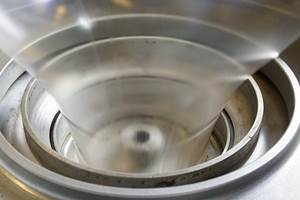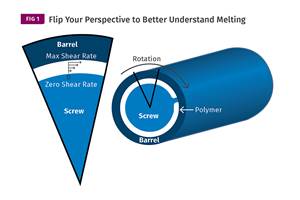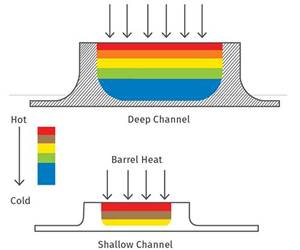Flatter Film Extrusion For the Win
When Charter Films began operations three years ago in Superior, Wis., its goal was to supply high-end converting markets in the region with blown films of better quality than those of much larger rivals.
When Charter Films began operations three years ago in Superior, Wis., its goal was to supply high-end converting markets in the region with blown films of better quality than those of much larger rivals. Charter also aimed to win customers with deliveries two to four times faster than its competitors. Charter ships rolls of monolayer and coextruded films with one- to two-week lead times. "That is is almost unheard of," according to David Timm, v.p. of technical services. "Four- to six-week lead times are normal."
As for quality, he says, "Our claim to fame is consistency--flatter film. Our typical monolayer films may have only ±3% thickness variation, which makes a big difference to the converter." Charter's films are typically in the 1-10 mil range. "We offer wide films [up to 100 in.], big rolls [up to 39 in. diam.], and flatter films--all with tight gauge tolerances. We don't try to be thinner or cheaper," says Timm.
Charter occupies a restored knitting mill in downtown Superior, renovated by cutting lozenge-shaped holes through four massive concrete floors and raising the roof to cover the two 75-ft film towers. Charter runs two Varex blown-film lines from Windmoeller & Hoelscher Corp., Lincoln, R.I., and will soon install a third. The company went to seven-day production within months of start-up and has run mostly full tilt ever since. The W&H lines have 15-20% higher outputs than the industry average, says Chris Trapp, v.p. and general manager of Charter.
Right tools for the job
To run fast and run precisely, Charter invested in top-of-the-line processing equipment. It has a 103-in. monolayer Varex line and an 83-in. three-layer line. The new one will be a 63-in. three-layer system, which will be shown at NPE before it goes to Charter. Like the two current lines, the third will have W&H's Optifil P-2 die controls adjusting film thickness in a closed loop with capacitance thickness gauges. It also will have a horizontal oscillating haul-off with air-cushioned rollers for tacky seal layers, a dual surface winder, and real-time computer monitoring and quality control. (At NPE, you can watch Charter's plant operating in real time.)
The two existing lines get in-line, double-sided corona treatment. Charter was one of the first installations of high-end universal treaters from Pillar Technologies, Hartland, Wis. They have removable electrode cartridges, which permit more uptime. Both lines also have Pillar's new P6000 power supply, which allows flexible tuning of treatment levels on the fly to match the resin characteristics. The new line will have a compact configuration of three universal treaters with P6000 power supplies to provide four-sided treatment. Pillar sources say it is the first triple use of its high-end treater.
Lots of products
Charter now has a slate of over 50 custom products. Monolayer films include PE sealant layers and films for coating, masking, and metalizing. Three-layer products include non-barrier PE sealant films, films for air-freight pouches, two-colored film for tapes, and soft thermoformable films with an ionomer core and PE surface layers. When the third line is in place, it will give Charter more capacity to try out new resins and develop new products.
Charter's staff is small and highly cross-trained in different jobs throughout the plant. That's why only one supervisor is needed for four-shift, seven-day operation. There is also no maintenance staff. Instead, Charter hires operators with two-year technical degrees and experience as an auto mechanic or similar machinery background. The operators are responsible for maintaining their machines.
All employees are charged with keeping the plant immaculate. "In their first two weeks here, everyone learns to run the floor scrubber," says general manager Chris Trapp. "A clean plant sets the tone for everything else." Even the controller, Paul Maki, knows how to operate the floor scrubber and the forklift. But as the company has grown, Maki notes, he doesn't have much time anymore for loading film rolls onto trucks.
Related Content
How To Identify Resin Degradation in Single-Screw Extruders
Degradation can occur in many single-screw extrusion operations, and typically occurs due to minor design flaws in the screw. Here is how to track it down.
Read MoreReduce Downtime and Scrap in the Blown Film Industry
The blown film sector now benefits from a tailored solution developed by Chem-Trend to preserve integrity of the bubble.
Read MoreUnderstanding Melting in Single-Screw Extruders
You can better visualize the melting process by “flipping” the observation point so the barrel appears to be turning clockwise around a stationary screw.
Read MoreThe Importance of Barrel Heat and Melt Temperature
Barrel temperature may impact melting in the case of very small extruders running very slowly. Otherwise, melting is mainly the result of shear heating of the polymer.
Read MoreRead Next
For PLASTICS' CEO Seaholm, NPE to Shine Light on Sustainability Successes
With advocacy, communication and sustainability as three main pillars, Seaholm leads a trade association to NPE that ‘is more active today than we have ever been.’
Read MoreMaking the Circular Economy a Reality
Driven by brand owner demands and new worldwide legislation, the entire supply chain is working toward the shift to circularity, with some evidence the circular economy has already begun.
Read MoreLead the Conversation, Change the Conversation
Coverage of single-use plastics can be both misleading and demoralizing. Here are 10 tips for changing the perception of the plastics industry at your company and in your community.
Read More











